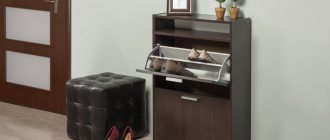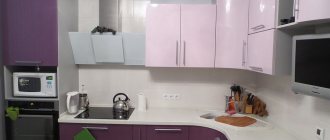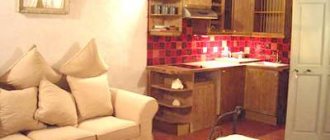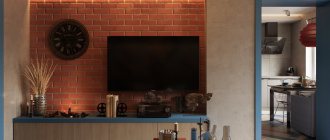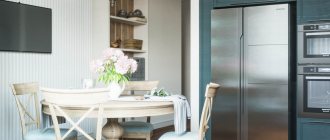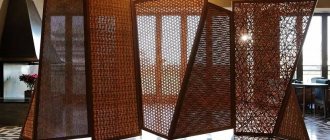If you realized that you understand LOL dolls no worse than the characters of “Game of Thrones”, you know the difference between bodysuits and vests and you spent more money on Elsa’s dress than on your own New Year’s outfit, then... Congratulations, you are a real caring parent !
If before the pain was missing a pair of Jimmy Choo shoes on sale, now you just know what it’s like to step on Legos at night.
Until recently, the apartment was a cozy place for parties, late-night movie shows and simply innocent sybaritism. And now your home is mountains of toys, scattered tights and outright rubbish that moves throughout the apartment without any logic.
The attic comes to the rescue: there is a very real way to put everything in its place and become a master of order and cleanliness in the nursery!
Lifehacks for storing children's things
Organizing the storage of children's things is a whole science. And here you will have to learn to stop finding dinosaurs in your bed, and under the dining table there is a whole city made of Lego, where you are an uninvited giant guest.
We'll tell you a couple of unusual life hacks, teach you the basic rules for sorting and storing things in a children's room, and show how logic can help you organize space wisely. Believe me, if now you feel like a freshman, by the end of the article you will become a certified specialist in storing children's things. So, let's begin!
Will never come in handy
We know and understand everything: you carefully selected every item without exception, you may have ordered something even from overseas, and this crimson bodysuit with sheep - yes, you went to the other end of town for it! But, alas, if you want to become a master of storing things in a children's room, then you need to pass the decluttering exam with a solid A - namely:
- get rid of all the clothes the child has outgrown,
- give away all the toys he no longer plays with,
- throw away everything that “we’ll fix someday”
- get rid of devices that are no longer useful.
And not an obvious point: remember that you are in a nursery and just think: if a thing doesn’t make you happy, then... Maybe it’s not needed at all? After all, what you once dreamed about, wanted, liked, may simply cease to bring pleasure. A great idea is to give it to someone to whom it will truly bring sincere joy.
Sorting clothes by season
Be sure to arrange your clothes so that there are separate places for items intended to be worn in different seasons. Put the clothes that you won’t use away, and put those that your baby needs right now closer to you. Additionally, while sorting, you will be able to determine what you can still wear and what items of clothing have become too small (children grow quickly, so clothes need to be updated frequently).
After a breakup, psychologists advise “cleaning up” your social media pages.
The first waste sorting complex will be launched in Sochi in 2021
In general's uniform: Soviet actors who created the images of generals on screen
Become a classification genius
Look now in the kitchen cupboard with dishes. Forks lie with forks, spoons with spoons, and mugs with mugs. Surprised? Of course not. Organize a storage system in the children's room using the same principle. Store items of the same category together. Children love balls, soft tigers and lions and, of course, construction sets. Buy three large boxes or baskets and organize everything into categories.
A common mistake all mothers make: storing clothes together with toys. Share this universe! The planet of pink ponies is not your territory, let there be chaos over which you have no control. But organizing the storage of children's clothing is your responsibility: wash, iron, and arrange. So let there be iron order there, and no UFO will encroach on your property.
Teenager's room
The storage system in a teenager's room is different. A teenager will most appreciate approaching his room as if it were his own separate apartment, where he can spend most of his time. Regardless of size, a bedroom should be versatile to allow you to do homework, hang out with friends, relax and sleep while reflecting your personality.
On a note! Teenagers and organized rooms are a rare combination. Messy bedrooms seem like a rite of passage for teenagers.
Proper storage options are one feature they probably haven't thought about but will overall appreciate. Any teenager will like this hanging wall organizer with pockets; it is convenient to store small school supplies or accessories, saving space on the floor. This toy storage system is made with your own hands and hung on the door with a hook, or attached to the wall. These storage items will keep your bedroom tidy and functional:
- chests of drawers;
- rack;
- under-bed storage containers;
- storage benches or ottomans;
- bedside tables.
Combining functionality with personality is the key to creating a space they'll love for years to come and keep their kids' room organized with their own hands. It is important for a teenager to participate in the creation of a creative space that will be comfortable, functional and will correspond to the teenage style.
How to organize storage of children's things: basic rules
Rule #1. Sorting. This will seem completely radical, but the result is worth it. Look up from the article, go right now and take everything out of the cabinets and into the center of the room. Absolutely everything: what was always shifted from place to place in search of shelter, what was hidden every time on the farthest shelf before guests arrived, what was stuffed into the “rubber” drawer of the children’s bedside table every time. Open this Pandora's box already! Pulled out? Have you looked at this carnival of colors, sizes and shapes? Now divide everything into 5 groups:
- cloth,
- shoes,
- toys,
- books,
- little things.
Now we’ll deal with each group of children’s goods separately and organize a storage system for things in the children’s room.
Rule #2. Storage of children's clothes and shoes. It is better to store all clothes in one place, having previously allocated shelves for underwear. Remember that, after all, you are not in your room, but in the nursery - let your child label the shelves or drawers himself. This way he will remember better where everything is stored and will understand that all this fuss with order is not your next hysteria, but a serious operation. You’re not joking that you want to win back the taken lands for yourself, right?
Hang everything that is relevant on hangers and put it on shelves, and all the off-season stuff - in a vacuum bag (hello, Ikea!) and in the farthest corner. We bet that no one has an extra far corner, so welcome to our Attic. Who better than us will take care of winter and summer clothes. We are clean, dry and warm at any time of the year, and we will give everything away as soon as we need it.
Rule #3. Toys and books. Toys - in baskets, boxes and boxes. Pocket organizers that hang on the side of the bed or wall, baskets on rails, storage boxes hidden under the bed, in chairs, at the head of the crib, classic shelves on the entire wall (why not) - everything has already been thought up for you, look for it and find something to suit your taste. It is better to store books vertically on the lowest shelves in open access.
Rule #4. Small items. The main idea is to store small items in containers with lids. There is nothing worse than accidentally dropping a box of the smallest Legos on the floor. Close all the little things under a tight lid in a transparent box: both you and the child will immediately see what’s inside and won’t have to open it again. For the same purpose, stick on labels. Remember who has to sign everything? Yeah.
How to instill in your child a love of order
Toys are scattered on the floor, you constantly trip over them, and everything in the closets is turned upside down... And no matter how hard you try, spinning like a “squirrel in a wheel,” maintaining order becomes more and more difficult.
If this situation is familiar to you, then read on.
Place things vertically, not in a pile
A great idea is to stack the game boxes vertically, like books.
“It is more convenient to store almost all items, be it folders, books or boxes, not in a stack, but on their side. Then they are equally easy to get.”
Craft cardstock, coloring books, and paperback books can be conveniently stored in vertical office paper trays. Trays can be made with your own hands to the desired size. Thin books and colored paper can be placed in file folders, signed and also placed vertically.
Ideas for storing clothes
So that the child can dress himself and put things away himself, it is worth providing a lower rod in the closet at the level of the child’s height. And you can build an even more interesting design:
“To teach children to have order in their clothes, I came up with the following design: I bought a towel dryer and 20 hooks for it. I hung the dryer at a height of 1.2 m. Now each child, when taking off his clothes, hangs them on a hook, they are not lying around anywhere, a lot of things fit in, and the upper part of the dryer is used to store hats. This system is suitable for outerwear, as well as those things that have loops (sweatshirts, pants). By the way, you can always sew such loops yourself.”
Our readers recommend keeping separate boxes for small clothes and linen. This makes it easier to find the items you need. Plus, it’s much easier to tidy up one box than an entire shelf.
It is convenient to store out-of-season clothing (for example, hats, mittens, shawls) in vacuum bags. This way it is reliably protected from dust and moths and takes up less space.
Each set of children's bedding can be folded into its own pillowcase, thanks to which the child will be able to get everything he needs to make the bed at once.
Use delimiters
Use the main feature of children's clothing: it is small. And the shelves of the closets are made as standard for adult clothes. Use dividers and you will double the storage capacity of your closet! We show clearly what shelf dividers are.
On AliExpress, such things cost pennies, but your nerves are priceless.
Logic is the key to convenience and practicality
Adjust storage systems to suit your child's needs. What you need every day should be in sight. If your child is a young artist, put a box of pencils and albums on the table, and put plasticine and other supplies in the box: you can take them out as needed. If your child wears sports clothes more often, let them be stored on the shelf that is most convenient for his height - the one at arm level. If you often read books, place them all on the lower floors and place them vertically: you will find and get the book you need in no time.
Multifunctional hanging organizer
A hanging organizer will help you organize a lot of shoes or other items of clothing. You can buy it or make it yourself, for example, sew it from thick fabric (alternatively, it is permissible to use a leather substitute, durable oilcloth, etc.).
To prevent diseases and a few more reasons to include spicy foods in your diet
Pensioners built a “Useless Machine” during quarantine: photo
Scientists use artificial intelligence to fight coronavirus
The organizer looks very stylish, takes up little mounting space, and can store a lot of things or objects. If you wish, make not one, but several similar designs.
Walls as storage space
If you don't like shelving or don't have room for classic cabinets, then there's only one word you need to know - pegboard. Fashionable, cheap, practical, unusual, in a word, all the advantages!
A pegboard is a perforated panel for wall storage of various items. The holes are intended for fastening hanging elements, shelves, baskets, hooks, etc. Next time you are in a mass market store, take a closer look, they use the same principle. You can move the shelves whenever it is convenient and do it for different tasks. By and large, you can even hang a child’s bicycle on such a wall so that the wheels don’t stain the floor.
In the hallway you can hang jackets, caps, hats, and belts on a pegboard. In the nursery, this will become a space for imagination: hang the shelves in a chaotic manner and experiment with books, games, and stationery. After all, the pegboard does not have to be on the entire wall, it can be a mini pegboard for creative supplies (hang scissors, tape, shelves for boxes with stickers and felt-tip pens - the child knows best, let him design it himself).
How to clean up your nursery in 5 steps
In order for a child to learn to play independently and clean up toys after themselves, it is enough to follow three principles:
- Give your child free access to toys so that he can pick them up and put them in place without your help. You need to look at the children's room and decide where everything will be located so that the child is comfortable. Find suitable furniture and arrange suitable activities for the child on shelves and racks.
- Help maintain order. When there are few toys and each thing has its own place, the child will simply return them to their place. For a child under one year old, five toys are enough, and from two to three years old - ten. It is better to remove the rest and change them once a week.
- Choosing useful toys according to the age and needs of the child - this is how we create an environment in which natural development occurs without stress and hysterics.
Let's see how we can put all these principles into practice.
We start putting things in order in the nursery by sorting toys.
Step 1. We sort out toys and books
When the child is not at home, remove all games and toys from cabinets, baskets and drawers and place them in the middle of the room.
Put your baby's favorite toys aside. They may not meet any standard of correctness, but if the child is attached to them, they should be left. There is no need to store them all in the open - you can put 2-3 toys and put the rest away so you can change them later. Or get it if the baby asks.
Prepare several bags or boxes:
- for toys and books that need to be thrown away;
- give;
- set aside for growth;
- use now (good toys).
Below is a list of toys that are best thrown away or donated.
Complex and incomprehensible toys. We include squeaking, talking, ringing, sparkling, and with several functions at the same time. There is too much in such toys and the child does not know what to concentrate on, his attention is scattered, and he quickly loses interest. And talking toys and books can become an obstacle to the development of speech, because speech develops only in communication with adults.
If a child throws toys around or calls you to play together, then most likely the toy is too complex or incomprehensible, that is, it does not help development in any way.
Let's take busy boards for example. These are toys with many locks, switches and other objects that can be pulled, pressed, or opened. The child does not have time to concentrate on one thing.
In addition, locks on busy boards come in varying degrees of complexity. A one-year-old baby who has failed to open some locks several times loses interest in them, and then in the entire bodyboard. And even when he grows up to cope with these locks, interest may not return.
Toys that the child has already grown out of: rattles, baby squeakers, hammers, pushchairs. Such toys do not contribute to development if the child has outgrown them and simply take up space in the room. They also encourage the baby to mindlessly twirl the toy in his hands and immediately throw it away.
Stuffed Toys. For most children, such toys are of no interest or use, but they collect a lot of dust and can cause allergies. You can leave 1-2 toys that the child loves and get rid of the rest.
Unrealistic toys. A child under 3 years old understands how the world works and it is important to help him acquire a real picture and the correct image. Cars with a human face give false ideas about the world, so it is better to leave cars that are similar to those that a child sees on the street and in books.
Incomplete sets, broken toys. The child should have a complete picture. In addition, a broken toy does not serve as an example of neatness. These could be puzzles with missing pieces, a pyramid missing several rings, a car without a wheel.
Duplicate toys perform the same task and only take up space. For example, a room may have several options for pyramids, sorters, and puzzles. It is enough to have 2-3 different colors, materials, shapes and change them from time to time.
We remove toys for growth and some of the parts When a child sees an interesting toy, but cannot cope with it, he loses motivation and interest in the toy, as is the case with a busy board. He will not return to her, even when he is ready. Therefore, it is better not to get ahead of events in order to maintain the child’s interest. Collect complex toys in a separate box so they can be offered later.
Musical instruments should also be age appropriate. For example, a two-year-old cannot handle a flute, but a clay whistle is just right. It is better to place one bell first, and then add one at a time and compare their sound. Avoid cheap musical instruments with poor sound - they can harm the child’s hearing development and dull perception.
Limit the number of details. Construction sets, puzzles, sorters are useful toys, but only on condition that the child can cope with the task posed by the toy. The large number of elements of these toys can prevent this.
Therefore, in the case of construction sets, you need to leave such a number of parts that will be enough to figure out what this toy is intended for. At the same time, there should be few of them so that the child can independently put all the parts back in place. If the baby easily copes with 5 parts, you can add a couple more elements, then more.
We sort the books. Until the age of three, it is important for a child to understand how the world around him and himself works. Therefore, it is better for books to be realistic, with aesthetic pictures and touch on the baby’s world.
If a child does not yet have very well developed fine motor skills, then it will be difficult for him to turn through thin pages and he may tear them. Therefore, for kids it is better to choose books with dense pages.
We remove:
- torn and wrinkled books;
- books that the child has already outgrown;
- duplicates or books of the same type;
- large thick books - the baby will not be able to take them and put them away himself, and the amount of information is too large to immerse himself in “reading”.
- books with fairy-tale characters.
Step 2. Zoning the room
For a child, landmarks are important when everything around is clear and familiar. And first of all, this concerns your home - the place with which he gets acquainted first of all, where he learns order and independence.
If you designate the necessary zones in the apartment and determine a place for each thing, you can get the following result:
- The child will feel calm and safe.
- Will be able to choose his own occupation.
- Learn self-care faster.
- Learn to maintain order faster.
- Will be able to express his needs even before he learns to speak. For example, going to your chair in the kitchen or a shelf with clothes.
There are 4 main zones for a child: sleep zone, eating zone, self-care zone, movement and creativity zone.
Toys and books are most often located in the area of movement and creativity. It can be in several rooms, for example, in the nursery and living room. But it is important that the child has the opportunity to use it independently - get the right toy, put things in order. All materials must be age appropriate and arranged logically. For example, musical instruments are in one place, creative activities are in another.
Let's consider how to design a place for toys, creativity and physical activity in order to interest the child and create a truly developing space.
We arrange a place for toys. Low racks with open shelves, proportional to the child, are suitable so that he can easily reach the necessary toys. Racks can be with or without cells. It is better to choose neutral colors - white or wood color - because bright colorful colors of furniture distract the child from what is on the shelves.
If it is not possible to purchase special furniture, there are several available options: unscrew the bottom doors of a regular cabinet with shelves, so the child will have free access to toys; use parts of furniture - for example, lay a narrow cabinet horizontally; fasten wooden boxes together.
Open small baskets: you can put construction sets, balls, themed sets and several small toys in them.
Bad options: closed and large baskets, containers and boxes. In them, toys are piled up and in order to find your favorite toy, you need to dump out everything else. In addition, the child may forget where everything is and not find the toy he would like to play with.
We create a place for creativity. Materials for creativity can stand on a separate shelf, in a separate rack, or occupy part of the shelf next to the toys. An easel will come in handy - you can lay an oilcloth or a washable rug under it. It’s good if there is a low table and a chair so that the child can sit down and do some creative work: sculpt or draw.
An article with ideas and examples for arranging a creativity zone
We set up a place for reading books. To make a place attractive to a child, you need to make it really cozy. Choose a small armchair, ottoman, high chair or large pillow.
For books, the best option is a special book rack, a shelf on the wall with crossbars that will prevent books from falling, or a basket on the floor.
It’s great if in this corner there is a place for a beautiful lamp, a floor lamp, a flower and a painting or photograph. They should not distract from reading, but at the same time they will help create an atmosphere of comfort.
We design a place for physical activity. Children at this age most often do not need special stimulation to move - for them this is life and the main source of development. The main thing is to create a safe space where there will be as many options for activity as possible.
It is ideal if the apartment has space for a sports complex - you can climb, hang, and spin on it. But if there is no room for it, you can put a basket with balls, hang a basketball hoop and crossbar, buy or make a hoop, use a hoop and other small sports equipment.
Free lessons from experts
They will help you take the first step in creating a developing space for your child at home
Step 3. Arrange everything on the shelves
Principles for placing toys and materials on the shelf:
- There should be as many toys as the child can put away on his own or with a little help from you: in a year it can be 5 toys, in 2 years - from 5 to 10 toys, etc.
- Each toy should be placed so that it is easy for the child to get it and put it in place. You should not put toys in such a way that the child will have to take one out to get another. If the toy consists of several parts, then it is better to put it on a tray or in a small basket.
- We change toys every one to two weeks, focusing on the child’s interest. If he is now interested in cars, then leave a couple - of different sizes or purposes. But at the same time, let there be one designer and a set of tools. As soon as you notice that interest in cars has disappeared, then it’s time to thin them out and add another designer.
It is better to place each set of materials for creative activities (drawing, modeling, stickers, appliqué) on a separate tray, in a box or basket, that is, 1 activity - 1 tray.
For example, on a drawing tray you can put 1 sheet of paper and 2-3 pencils, no more. On a tray for modeling there can be a closed container with modeling dough and plasticine, the base can be placed on the table (it can also be directly on the table), the tools can be placed directly on the tray or in the container - a couple of molds, a stack or a knife.
There should not be many books available to the child. For children under 3 years old, 3–5, maximum 7 books are enough. The rest can be removed and changed according to interest or once a week or two. Books should be placed facing the child so that he can see the cover. Make sure they are easy to take out and put away.
Step 4. Remove excess from the eyes
We've sorted the toys with you and now it's time to get rid of the unnecessary ones.
Broken and harmful toys can be thrown away, recycled, or set aside to be repurposed and used in other games later. For example, from the puzzle pieces you can later make an applique, etc.
Duplicates and toys from which the child has outgrown can be given to relatives, friends, taken to the playground, sold on Avito, donated to charity, or exchanged.
Charitable foundations: Russian Birch, Mercy, Volunteers to help orphans. Communities for toy exchange: Daru - gift, Babyblog, Tumbler. Services that can come and pick up toys: Croc and Zyabra, Suitcase, Second Wind.
The remaining toys for the shift should be stored where the child will not find them: in boxes or containers in the closet, in the pantry, on the top shelves.
Toys can be rented or leased - this will save both space and money. In addition, this way you will contribute to protecting the environment from excess waste. Toy rental services: Arendorium, Toyrent.
Step 5. Prepare the child
You've done a lot of work and you're probably happy with the result - there's more space and air in the nursery, and the irritation from having toys lying around has gone away. Now we need to see how the child reacts to these changes.
Most often, children freeze in surprise at the threshold, and then disappear for a long time, carefully examining each toy, as if rediscovering them for themselves.
It is important to remember that at this age, for a child, familiar order or even disorder is the basis of stability. This means that he may perceive sudden changes, even for the better, in a completely different way than we expected - with tension, stress, demands to return everything as it was. Based on the characteristics of your baby and, perhaps, change the nursery gradually: dismantle one rack with toys, next time organize a reading area.
Explain to your child that now each toy has its own place and it will be easy for him to find and take what he wants when he decides. It also freed up space for dancing, sculpting and drawing.
Beds as storage space
www.ikea.com
A functional bed is a trend not only for children. New York style, replacing the Scandinavian coziness, will become close to everyone who is limited in space. This is where beds with built-in storage drawers come in handy. We are used to the fact that we can put our laundry there, but now we can order a functional bed with drawers of different sizes and store clothes, shoes, personal items, art supplies and, of course, toys there.
www.pinterest.com
Lifehacks “here and now”
If you don’t yet have the opportunity to purchase a functional bed or replace shelving, we offer a couple of useful ideas that can be applied right now.
Curtains. Create the illusion of minimalism by curtaining open, congested areas with fabric in your favorite color.
www.pinterest.com
Laundry basket. A dirty child is a normal child. That’s why you don’t have a “week” set, but rather a “monthly” set, that is, about 20 T-shirts for 5-7 days! From your child’s clothes, you can easily guess where he was and what he was doing: eating pizza, drawing with felt-tip pens, playing with kinetic sand.
T-shirts are changed, and dirty laundry needs to be stored somewhere. Place a basket for it right in the room next to the closet. Teach your child the rule: take off dirty items and put them in the basket. If he learns it, you will forget what dirty clothes are scattered throughout the apartment.
www.houzz.in
Hooks to work! Hooks can be hung on the wall to store jackets, tracksuits, bags and backpacks. They can also be attached inside the cabinet directly to the door. Well, the real hit of the season are chairs with hooks for clothes. Coming home from school, hanging your jacket on a chair, doing your homework, immediately throwing it back on and running off for a walk - convenient! And the chair can also be a ladder at the same time - then the child will have free access to the upper shelves. You can store desktops there, for example, which he can get out himself without interrupting you from worries around the house or work.
The results of your efforts
All our advice is aimed at ensuring that you do not rebuild your apartment into one large children's room, but make the child's room an organized, smart space in which it is cool to play, you can easily find your favorite thing and conveniently use the dressing room.
But we know that there are always more children's items than an ordinary apartment can accommodate. Therefore, we suggest handing over all seasonal clothes, favorite toys that are dear to you, and a stroller for your future sister or brother to the cloud storage warehouse. In our Attic, things are stored in ideal conditions: always +20 degrees, cleaning and ventilation strictly once a week, and 24-hour security with video surveillance.
Our movers come to your home themselves, carefully pack and take children's things for storage. Parents are our regular customers, as every season we store scooters, bicycles, skateboards, strollers, cars, and seasonal clothing.
www.amazon.com
This huge plush Dalmatian here could be collecting dust and taking up a ton of space in a nursery, but instead it is stored in our warehouse and the client will receive it back safe and sound. Why part with something dear forever when you can give it to us?
Taking care of you and your things, Attic.
How to properly and compactly fold children's clothes into a chest of drawers?
If you ask any number of moms how they fold their baby clothes, chances are you'll get different answers. Some moms use the KonMari method and have a super organized closet for their baby. Others may quickly roll things up to get the job done.
Before we show you how to fold baby clothes, let's look at these methods and compare them.
KonMari Method
If you've been on this earth since at least January of this year, you've probably been exposed to the Konmari method. This technique was developed by Marie Kondo and focuses on organization that “ignites joy.”
This method follows six rules:
- Dedicate yourself to the idea of cleaning.
- Imagine how you want to live.
- Complete deleting items before organizing.
- Organize items neatly by category, not by location.
- Follow the correct order.
- Ask yourself if putting things away sparks joy.
When it comes to clothing, the KonMari method uses a folding method that allows the folded clothing to stand straight up. This is also known as the “filing” method and makes them more accessible and organized.
Many parents (and people in general) prefer this style of folding over the traditional technique. This is because they can see everything they have. When folding children's clothes rather than your own, the folding process is only slightly different.
I actually fold my baby's clothes this way and it makes getting ready for the morning so much faster.
Traditional folding of clothes
This is probably the folding method you're used to, with clothes stacked on top of each other in separate drawers. Some people think it's better than the Konmari method.
But when you have to pick through a bunch of other clothes just to find what you want, it turns out to be impractical. It can be inconvenient if you can't find the right shirt to wear without tearing your drawers apart.
We prefer the KonMari method because it makes clothes easier to access. Plus, by seeing everything at once, your child can't outgrow something before they can wear it.
